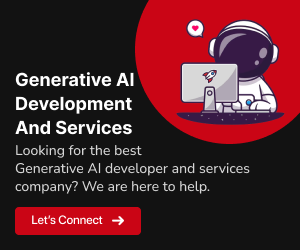In today’s digital age, achieving personalized user experiences in apps is non-negotiable. Generative AI, driven by deep learning, is the transformative force in app development that makes this possible. From app interfaces to content recommendations, users expect tailor-made interactions. But how does Generative AI work, and what can it do for your app? Let’s dive in and explore the power of Generative AI in creating unique, user-centric apps
The Power of Personalization
Personalization isn’t a new concept in technology. For years, companies have been collecting user data to provide customized content and recommendations. However, the emergence of Generative AI takes personalization to a whole new level.
Generative AI, powered by deep learning algorithms, can understand, analyze, and generate content that is specific to each user. This technology has been applied in various fields, from natural language processing to computer vision. When it comes to app development, Generative AI allows developers to create apps that adapt and evolve with the individual needs and preferences of users.
When it comes to app development, Generative AI allows developers to create apps that adapt and evolve with the individual needs and preferences of users. Learn more about this in a recent article on app personalization.
How Generative AI Works
Generative AI is a subset of artificial intelligence that focuses on creating content rather than simply processing data. It relies on neural networks, which are designed to mimic the human brain’s structure and function. Here’s a simplified overview of how it works:
Data Collection: The Foundation of Learning
The process of creating tailored app experiences using Generative AI begins with Data collection. This critical phase involves gathering a vast and diverse dataset that encompasses various forms of content, such as text, images, or even entire apps. The richness and diversity of this dataset are essential as they serve as the raw materials from which the AI model learns. By exposing the model to a wide array of examples, it gains the ability to recognize patterns, discern correlations, and understand the intricate relationships between different elements. The quality and comprehensiveness of the dataset lay the groundwork for the AI model’s subsequent learning and creative capabilities.Training: Refining the Creative Mind
Once armed with a comprehensive dataset, the AI model enters the training phase. Here, it immerses itself in the data, utilizing it to adjust its internal parameters. This adjustment process is akin to fine-tuning the model’s creative abilities. Through countless iterations, the model learns to generate content that is not only coherent but also consistent with the patterns it has identified within the dataset. For app development, this means that the AI model acquires the skills to craft personalized user interfaces, offer content recommendations tailored to individual preferences, and even generate code specific to certain app features. Training is the crucible where the AI model transforms raw data into a creative powerhouse. You can find relevant articles on AI training on platforms like DeepAI, ArXiv, or OpenAI’s blog.
Generation: Bringing Creativity to Life
The true magic of Generative AI emerges once the model is trained. It can now autonomously generate new content based on the patterns it has internalized. In the context of app development, this translates into the ability to dynamically create personalized user interfaces that cater to individual tastes, curate content recommendations that align with user interests, and even generate code snippets for specific functionalities. The AI model becomes a co-creator, constantly producing content and features that are not only relevant but also engaging for users. This marks a fundamental shift in how apps are developed and experienced. You can find articles on Generative AI in app development on websites like TechCrunch, MIT Technology Review , or Forbes.Adaptation: Evolving with User Needs
Generative AI is anything but static. It possesses the remarkable capability to adapt and evolve over time. As it encounters new data and interacts with users, it continues to refine its understanding of patterns and preferences. This adaptability ensures that the personalized experiences it offers remain not just relevant but also increasingly attuned to the ever-changing needs and desires of users. In the fast-paced world of app development, this feature is invaluable, as it enables apps to stay ahead of the curve and consistently deliver experiences that resonate with users. You can find articles on Generative AI adaptation on sources like VentureBeat, Wired, or Harvard Business Review.
Applications in App Development
Generative AI has a wide range of applications in app development, enabling developers to create more engaging and personalized experiences for users:
-
Personalized User Interfaces:Tailoring Every Interaction
Generative AI’s capacity to customize user interfaces goes beyond aesthetics. It can dynamically adjust UI elements based on individual preferences, creating a fluid and intuitive user experience. Whether a user prefers a minimalist design with muted colors or a vibrant, information-rich layout, Generative AI adapts, enhancing user satisfaction. For more details, you can go through the articles on personalization in UI/UX design like The Importance of Personalization in User Experience. Content Recommendations: Guiding Users Seamlessly
Content recommendations powered by Generative AI transcend basic suggestions. This technology comprehends user preferences at a granular level, offering tailored product recommendations, curated news articles, and personally crafted video playlists. Users encounter content that resonates with their interests, boosting engagement and retention. You can read informative articles that delve into the workings of recommendation systems, such as “Understanding the Mechanics of Recommendation Systems.”Chatbots and Virtual Assistants: Natural and Contextual Interaction
Generative AI takes chatbots and virtual assistants to a new level of sophistication. These AI-powered entities engage users in natural, context-aware conversations. Whether it’s answering questions, offering product advice, or assisting with complex tasks, they provide personalized, human-like interactions, making users feel heard and understood. For a hands-on guide to building chatbots in Python, you can explore the article on Real Python titled “Building Chatbots in Python with ChatterBot.”Automated Content Creation: Instantly Tailored Information
Generative AI empowers apps to create personalized reports, summaries, and articles in real-time. Whether it’s generating investment summaries for a finance app or producing tailored news articles, users receive content that aligns with their interests and needs. This streamlines information consumption and enhances user engagement. For a deeper understanding, you can link to articles on AI-powered content generation, such as The Rise of AI in Content Generation on WordHero.Enhanced Security: A Non-Intrusive Shield
Beyond personalization, Generative AI plays a crucial role in security. It employs biometric authentication, analyzing user behavior patterns, such as typing speed and style, to enhance security without intrusive methods like fingerprint scans or facial recognition. This seamless yet robust security approach ensures user data remains protected. To elaborate on this, you can read articles on AI-driven security solutions, like AI in Cybersecurity by IBM.
Challenges and Considerations
While Generative AI offers tremendous potential for creating personalized app experiences, there are some important considerations:
Privacy Concerns: Responsible Data Handling
In the era of personalized experiences, safeguarding user privacy is paramount. Collecting and utilizing user data to craft tailored app experiences must adhere to stringent privacy regulations. Developers should implement robust data protection measures, including data encryption, secure storage, and anonymization techniques. Additionally, clear and concise privacy policies should inform users about how their data is used and provide them with opt-in or opt-out options for personalized features. Compliance with regulations such as General Data Protection Regulation (GDPR) and California Consumer Privacy Act(CCPA) is not just a legal requirement but also a commitment to respecting users’ privacy.Data Quality: The Foundation of Personalization
The quality of data employed to train Generative AI models directly influences the caliber of personalized experiences. “Garbage in, garbage out” holds true in AI development. To ensure accurate and valuable personalization, developers must curate high-quality datasets. This means collecting diverse and representative data, cleaning and preprocessing it meticulously, and continually updating it to account for evolving user preferences. By investing in data quality, developers can cultivate AI models that yield more precise and meaningful personalization for users.Ethical Considerations: Bias Mitigation
AI, including Generative AI, can inadvertently perpetuate biases present in the training data. Developers bear the responsibility of ensuring that AI-generated content and recommendations are ethical, unbiased, and devoid of harmful stereotypes. This necessitates a thorough examination of the training data for biases and the implementation of mitigation strategies such as re-weighting or re-sampling data to achieve fairness. Transparent algorithms and regular audits can help identify and rectify potential ethical concerns, fostering trust among users. For further insights on addressing bias in AI and the strategies involved, you can read Addressing Bias in AI: Strategies and Challenges on LinkedInScalability: Resource Challenges
The implementation of Generative AI in apps, while promising, demands significant computational resources. This requirement can pose challenges for smaller development teams with limited budgets and infrastructure. To address scalability concerns, developers can explore cloud-based solutions and leverage specialized AI platforms that offer scalable infrastructure on a pay-as-you-go basis. Collaborating with cloud providers can provide cost-effective access to the computational power required for Generative AI, enabling even smaller teams to embrace this technology. To learn more about using cloud computing to enhance your AI projects, you can refer to “How do you use cloud computing to enhance your data analytics ” on LinkedIn.
Advancements in Generative AI
Generative AI has witnessed remarkable advancements, equipping it with the ability to create increasingly realistic and engaging content. This evolution has positioned it as an invaluable tool for crafting personalized experiences, enabling businesses to tailor content to each user’s unique interests and preferences. Moreover, the proliferation of platforms and tools is simplifying the implementation of generative AI in apps, making it accessible to businesses of all sizes and fueling the adoption of this transformative technology.

Here are some specific examples of how generative AI is being used to create personalized experiences in apps:
Netflix’s Personalized Recommendations:
Netflix employs generative AI in its recommendation engine, which meticulously analyzes user data, including past movie and TV show preferences. This data-driven approach allows Netflix to generate highly personalized movie and TV show recommendations for each user.
Amazon’s Tailored Product Recommendations:
Amazon harnesses generative AI to produce personalized product recommendations. Their recommendation engine scrutinizes user data, considering factors such as previously viewed or purchased items. As a result, Amazon offers users tailored product suggestions, enhancing their shopping experience.
Spotify’s Customized Playlists:
Spotify takes advantage of generative AI in creating personalized playlists. Their recommendation engine dissects user data, including song listening history, to generate unique playlists that cater to individual musical tastes. Recently, Spotify even introduced an AI DJ feature to further elevate the personalized music experience.
Google Translate’s Adaptive Translations:
Google Translate leverages generative AI to facilitate language translation. The translation engine carefully assesses the source text and generates translations tailored to each user’s specific linguistic needs.
With the innovative contributions of GeekyAnts, these practical examples illustrate how generative AI is revolutionizing app experiences by adapting content to individual preferences. GeekyAnts, a leading tech company known for its expertise in web and mobile app development, adds a geeky touch to the world of generative AI, enhancing user experiences and driving innovation across various industries.
Conclusion
In summary, while Generative AI holds immense potential for creating personalized app experiences, developers must navigate several critical considerations. By prioritizing user privacy, maintaining data quality, addressing ethical concerns, and devising strategies for scalability, app developers can harness the capabilities of Generative AI responsibly and effectively. Balancing innovation with ethical and practical considerations will pave the way for a future where personalized apps enrich the lives of users while upholding their rights and values.
In our exploration of Generative AI, we also delve into the fascinating world of 3D modeling and printing, as seen in our article “Sculpting with Data: Generative AI’s Impact on 3D Modelling and Printing“

























